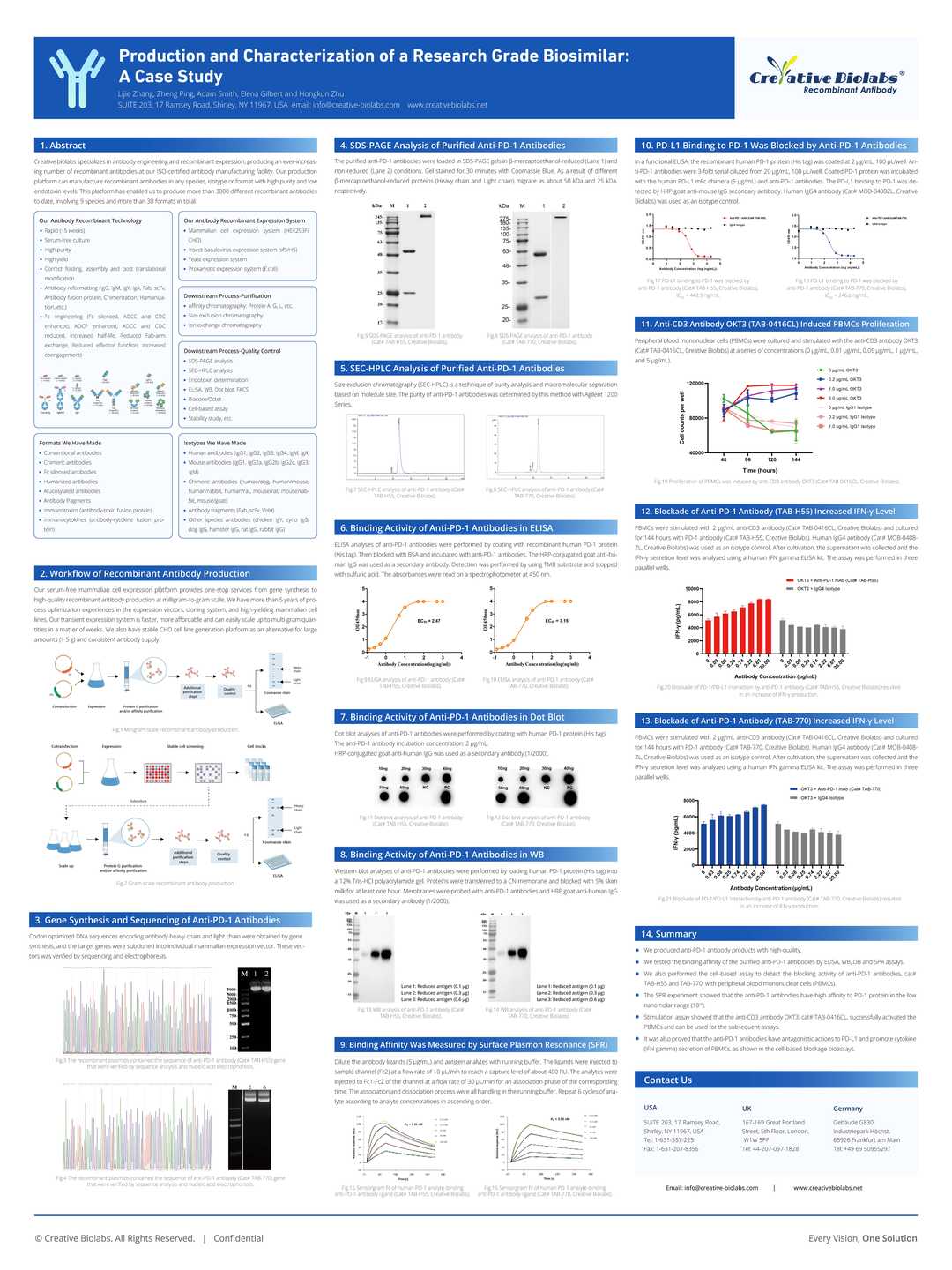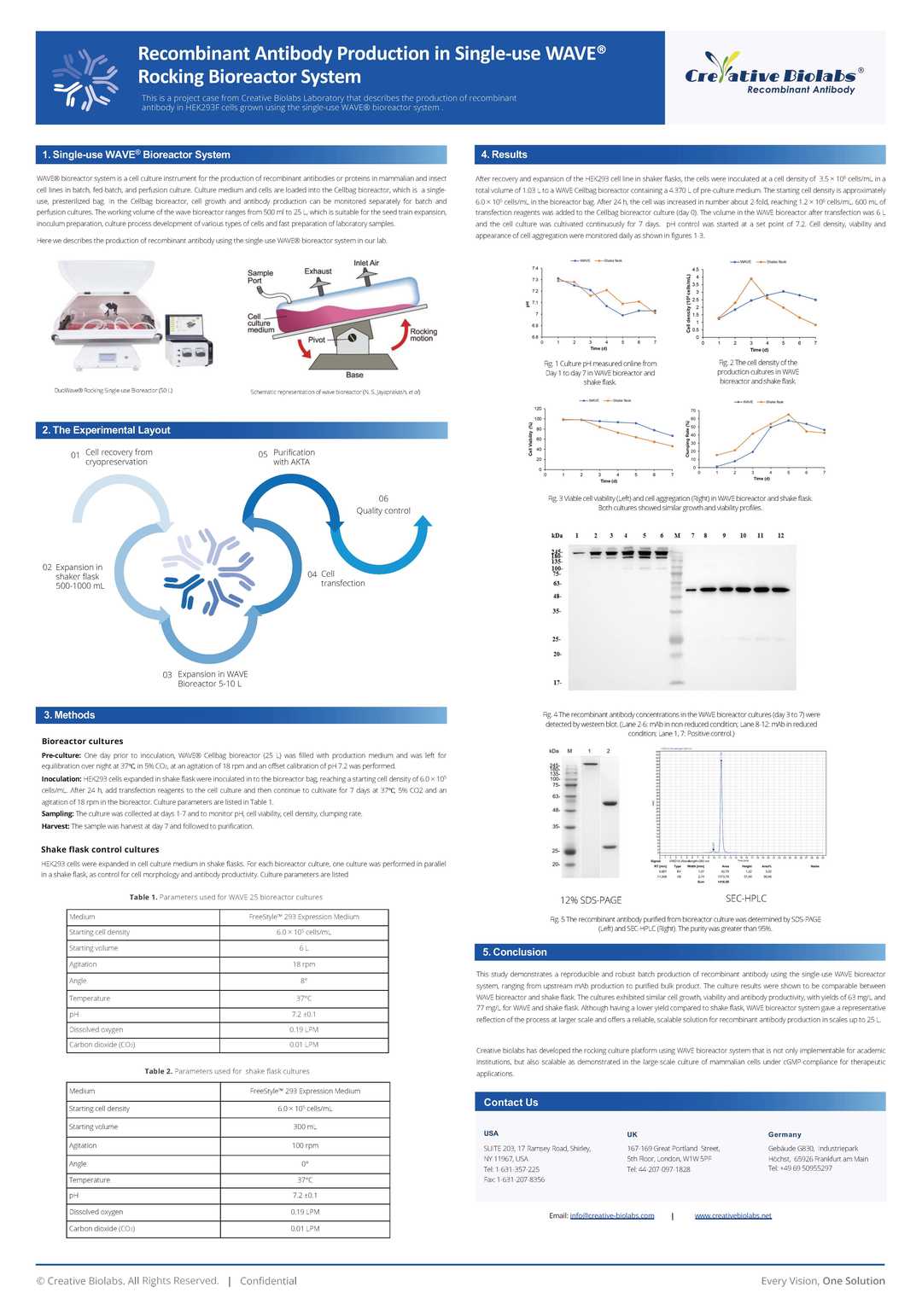Anti-MUC1 (clone 1B2) Recombinant Antibody Coupled Liposome (VS-1024-FY66)
CAT#: VS-1024-FY66
Liposomes that bind to anti-MUC1 antibodies show potential for enhanced therapeutic effects in breast cancer, as they can improve the effectiveness of radiotherapy and effectively recognize and kill MUC1-positive tumor cells. These liposomes can be used in combination with antibodies to leverage the advantages of immunotherapy, promoting improved clinical outcomes.









Specifications
- Potential Clinical Applications
- Breast cancer
Product Composition
- Clone
- 1B2
- Antibody Type
- IgG
- Antibody Host
- Humanized
- Antibody Reactivity
- Human
- Antibody Description
- This is a recombinant human monoclonal antibody targeting MUC1, which shows potential for use in the treatment of solid tumors.
Product Property
- Storage
- See in the COA
- Storage Shelf Time
- See in the COA
Target Information
- Target
- MUC1
- Introduction
- This gene encodes a membrane-bound protein that is a member of the mucin family. Mucins are O-glycosylated proteins that play an essential role in forming protective mucous barriers on epithelial surfaces. These proteins also play a role in intracellular signaling. This protein is expressed on the apical surface of epithelial cells that line the mucosal surfaces of many different tissues including lung, breast stomach and pancreas. This protein is proteolytically cleaved into alpha and beta subunits that form a heterodimeric complex. The N-terminal alpha subunit functions in cell-adhesion and the C-terminal beta subunit is involved in cell signaling. Overexpression, aberrant intracellular localization, and changes in glycosylation of this protein have been associated with carcinomas. This gene is known to contain a highly polymorphic variable number tandem repeats (VNTR) domain. Alternate splicing results in multiple transcript variants.
- Alternative Names
- ADMCKD; ADMCKD1; CA 15-3; CD227; EMA; H23AG; KL-6; MAM6; MCD; MCKD; MCKD1; MUC-1; MUC-1/SEC; MUC-1/X; MUC1/ZD; PEM; PEMT; PUM
- Full Name
- Mucin 1, Cell Surface Associated
- Gene ID
- 4582
- UniProt ID
- P15941
- Cellular Localization
- Cell membrane, Cytoplasm, Membrane, Nucleus, Secreted
- Post Translation Modifications
- Highly glycosylated (N- and O-linked carbohydrates and sialic acid). O-glycosylated to a varying degree on serine and threonine residues within each tandem repeat, ranging from mono- to penta-glycosylation. The average density ranges from about 50% in human milk to over 90% in T47D breast cancer cells. Further sialylation occurs during recycling. Membrane-shed glycoproteins from kidney and breast cancer cells have preferentially sialyated core 1 structures, while secreted forms from the same tissues display mainly core 2 structures. The O-glycosylated content is overlapping in both these tissues with terminal fucose and galactose, 2- and 3-linked galactose, 3- and 3,6-linked GalNAc-ol and 4-linked GlcNAc predominating. Differentially O-glycosylated in breast carcinomas with 3,4-linked GlcNAc. N-glycosylation consists of high-mannose, acidic complex-type and hybrid glycans in the secreted form MUC1/SEC, and neutral complex-type in the transmembrane form, MUC1/TM.
Proteolytic cleavage in the SEA domain occurs in the endoplasmic reticulum by an autoproteolytic mechanism and requires the full-length SEA domain as well as requiring a Ser, Thr or Cys residue at the P + 1 site. Cleavage at this site also occurs on isoform MUC1/X but not on isoform MUC1/Y. Ectodomain shedding is mediated by ADAM17.
Dual palmitoylation on cysteine residues in the CQC motif is required for recycling from endosomes back to the plasma membrane.
Phosphorylated on tyrosines and serine residues in the C-terminal. Phosphorylation on tyrosines in the C-terminal increases the nuclear location of MUC1 and beta-catenin. Phosphorylation by PKC delta induces binding of MUC1 to beta-catenin/CTNNB1 and thus decreases the formation of the beta-catenin/E-cadherin complex. Src-mediated phosphorylation inhibits interaction with GSK3B. Src- and EGFR-mediated phosphorylation on Tyr-1229 increases binding to beta-catenin/CTNNB1. GSK3B-mediated phosphorylation on Ser-1227 decreases this interaction but restores the formation of the beta-cadherin/E-cadherin complex. On T-cell receptor activation, phosphorylated by LCK. PDGFR-mediated phosphorylation increases nuclear colocalization of MUC1CT and CTNNB1.
The N-terminal sequence has been shown to begin at position 24 or 28.
- Protein Refseq
- NP_001018016.1; NP_001018017.1; NP_001037855.1
- Function
- The alpha subunit has cell adhesive properties. Can act both as an adhesion and an anti-adhesion protein. May provide a protective layer on epithelial cells against bacterial and enzyme attack.
The beta subunit contains a C-terminal domain which is involved in cell signaling, through phosphorylations and protein-protein interactions. Modulates signaling in ERK, SRC and NF-kappa-B pathways. In activated T-cells, influences directly or indirectly the Ras/MAPK pathway. Promotes tumor progression. Regulates TP53-mediated transcription and determines cell fate in the genotoxic stress response. Binds, together with KLF4, the PE21 promoter element of TP53 and represses TP53 activity.
Customer Review
There are currently no Customer reviews or questions for VS-1024-FY66. Click the button above to contact us or submit your feedback about this product.
Submit Your Publication
Published with our product? Submit your paper and receive a 10% discount on your next order! Share your research to earn exclusive rewards.
Downloadable Resources
Download resources about recombinant antibody development and antibody engineering to boost your research.
Datasheet
MSDS
COA
Certificate of Analysis LookupTo download a Certificate of Analysis, please enter a lot number in the search box below. Note: Certificate of Analysis not available for kit components.
- CAT
- Product Name
See other products for "Clone 1B2"
- CAT
- Product Name
See other products for "MUC1"
Select a product category from the dropdown menu below to view related products.
| CAT | Product Name | Application | Type |
|---|---|---|---|
| NAB-2049-VHH | Recombinant Anti-human MUC1 VHH Single Domain Antibody | WB, IP, ChiP, Neut, ELISA | Llama VHH |
| HPAB-AP504-YC | Recombinant Camel Anti-MUC1 Single Domain Antibody (HPAB-AP504-YC) | FC | Camel VHH |
| HPAB-AP505-YC | Recombinant Camel Anti-MUC1 Single Domain Antibody (HPAB-AP505-YC) | ELISA | Camel VHH |
| HPAB-0736-YJ-VHH | Camelid Anti-MUC1 Recombinant Single Domain Antibody (HPAB-0736-YJ-VHH) | ELISA | Camelid VHH |
| HPAB-0737-YJ-VHH | Camelid Anti-MUC1 Recombinant Single Domain Antibody (HPAB-0737-YJ-VHH) | ELISA | Camelid VHH |
| CAT | Product Name | Application | Type |
|---|---|---|---|
| TAB-173 | Anti-Human MUC1 Recombinant Antibody (TAB-173) | IF, IP, Neut, FuncS, ELISA, FC, ICC | IgG1 - kappa |
| TAB-H65 | Anti-Human MUC1 Recombinant Antibody (Sontuzumab) | WB, ELISA, FC, IP, FuncS, IF, Neut | IgG1 |
| TAB-H77 | Human Anti-MUC1 Recombinant Antibody (TAB-H77) | FuncS, Inhib | IgG1, κ |
| TAB-413MZ | Human Anti-MUC1 Recombinant Antibody (TAB-413MZ) | ELISA | Humanized IgG |
| TAB-026ML | Anti-Human MUC1 Recombinant Antibody (TAB-026ML) | ELISA, IHC, FC, IP, IF, FuncS | IgG1, κ |
| CAT | Product Name | Application | Type |
|---|---|---|---|
| AGTO-L036E | anti-MUC1 immunotoxin C242 (Fab)-PE | Cytotoxicity assay, Functional assay | |
| AGTO-L064E | anti-MUC1 immunotoxin H23 (scFv)-PE | Cytotoxicity assay, Functional assay |
| CAT | Product Name | Application | Type |
|---|---|---|---|
| TAB-412MZ | Human Anti-MUC1 Recombinant Antibody (TAB-412MZ) | ELISA | Chimeric (mouse/human) IgG |
| TAB-412MZ-S(P) | Mouse Anti-MUC1 Recombinant Antibody; scFv Fragment (TAB-412MZ-S(P)) | ELISA | Mouse scFv |
| TAB-412MZ-F(E) | Human Anti-MUC1 Recombinant Antibody; Fab Fragment (TAB-412MZ-F(E)) | ELISA | Chimeric (mouse/human) Fab |
| CAT | Product Name | Application | Type |
|---|---|---|---|
| TAB-431MZ | Anti-Human MUC1 Recombinant Antibody (PH1) | ELISA, WB, FC, IHC, SPR | Human antibody |
| TAB-432MZ | Human Anti-MUC1 Recombinant Antibody (TAB-432MZ) | ELISA, FC, FACS, DB, SPR | Human IgG |
| TAB-433MZ | Human Anti-MUC1 Recombinant Antibody (TAB-433MZ) | ELISA, FC, FACS, DB, SPR | Human IgG |
| TAB-434MZ | Human Anti-MUC1 Recombinant Antibody (TAB-434MZ) | ELISA, FC, FACS, DB, SPR | Human IgG |
| PABX-143 | Recombinant Human Anti-MUC1 Antibody (CTM01) | WB, ELISA, FuncS | IgG |
| CAT | Product Name | Application | Type |
|---|---|---|---|
| TAB-418MZ-S(P) | Mouse Anti-MUC1 Recombinant Antibody; scFv Fragment (TAB-418MZ-S(P)) | ELISA, SDS-PAGE, IHC | Mouse scFv |
| TAB-419MZ-S(P) | Mouse Anti-MUC1 Recombinant Antibody; scFv Fragment (TAB-419MZ-S(P)) | ELISA, SDS-PAGE, IHC | Mouse scFv |
| TAB-420MZ-S(P) | Mouse Anti-MUC1 Recombinant Antibody; scFv Fragment (TAB-420MZ-S(P)) | ELISA, IHC | Mouse scFv |
| TAB-421MZ-S(P) | Mouse Anti-MUC1 Recombinant Antibody; scFv Fragment (TAB-421MZ-S(P)) | FC, ELISA, IF | Mouse scFv |
| TAB-422MZ-S(P) | Mouse Anti-MUC1 Recombinant Antibody; scFv Fragment (TAB-422MZ-S(P)) | FC, ELISA, IF | Mouse scFv |
| CAT | Product Name | Application | Type |
|---|---|---|---|
| Gly-012LC | Recombinant Anti-Human MUC1 Antibody (Fab glycosylation/Sialylated) | ELISA, FC, IHC | Humanized antibody |
| Gly-120LC | Recombinant Anti-Human MUC1 Antibody (Fab glycosylation) | ELISA | Mouse antibody |
| CAT | Product Name | Application | Type |
|---|---|---|---|
| Gly-012LC-1 | Recombinant Anti-Human MUC1 Antibody (Fab glycosylation/Sialylated) | ELISA, FC, IHC | Humanized antibody |
| CAT | Product Name | Application | Type |
|---|---|---|---|
| Gly-109LC | Recombinant Anti-Human MUC1 Antibody (Fc glycosylation) | ELISA | Human antibody |
| CAT | Product Name | Application | Type |
|---|---|---|---|
| Gly-121LC | Recombinant Anti-Human MUC1 Antibody (Non-glycosylated) | ELISA | Mouse antibody |
| Gly-122LC | Recombinant Anti-Human MUC1 Antibody (Non-glycosylated) | ELISA | Mouse antibody |
| Gly-124LC | Recombinant Anti-Human MUC1 Antibody (Non-glycosylated) | ELISA | Mouse antibody |
| CAT | Product Name | Application | Type |
|---|---|---|---|
| BRD-0379MZ | Chicken Anti-MUC1 Polyclonal IgY | IHC, WB | Chicken antibody |
| CAT | Product Name | Application | Type |
|---|---|---|---|
| MHC-LC054 | PE-A*02:01/Human MUC1 (LLLTVLTVV) MHC Tetramer | FCM | |
| MHC-LC055 | APC-A*02:01/Human MUC1 (LLLTVLTVV) MHC Tetramer | FCM | |
| MHC-LC056 | BV421-A*02:01/Human MUC1 (LLLTVLTVV) MHC Tetramer | FCM | |
| MHC-LC781 | A*0201/Human MUC-1 (LLLLTVLTV) MHC Tetramer | FCM | |
| MHC-YF272 | A*02:01/Human MUC1 (LLLLTVLTV) MHC Monomer | MHC Multimer |
| CAT | Product Name | Application | Type |
|---|---|---|---|
| MOR-2320 | Hi-Affi™ Recombinant Rabbit Anti-MUC1 Monoclonal Antibody (DS2320AB) | IHC-P, IHC-Fr | IgG |
| CAT | Product Name | Application | Type |
|---|---|---|---|
| EPAF-0838LC | Recombinant Mouse Anti-Human MUC1 Antibody (SM3) | ELISA | IgG1 |
| EPAF-0581CQ | Recombinant Mouse Anti-Human MUC1 Antibody (B27.29) | Neut, FC | IgG1 |
| EPAF-0583CQ | Recombinant Mouse Anti-Human MUC1 Antibody (BC4E549) | Neut, FC | IgG1 |
| EPAF-0584CQ | Recombinant Mouse Anti-Human MUC1 Antibody (DF3) | Neut, FC | IgG1 |
| CAT | Product Name | Application | Type |
|---|---|---|---|
| FAMAB-0225-YC-S(P) | Mouse Anti-MUC1 Recombinant Antibody (clone MUSE11); scFv Fragment | IHC | Mouse scFv |
| HPAB-0872LY-S(P) | Mouse Anti-MUC1 Recombinant Antibody; scFv Fragment (HPAB-0872LY-S(P)) | ELISA, WB, FC | Mouse scFv |
| HPAB-0873LY-S(P) | Human Anti-MUC1 Recombinant Antibody; scFv Fragment (HPAB-0873LY-S(P)) | ELISA, WB, FC | Human scFv |
| HPAB-0874LY-S(P) | Mouse Anti-MUC1 Recombinant Antibody; scFv Fragment (HPAB-0874LY-S(P)) | ELISA, WB, FC | Mouse scFv |
| HPAB-0875LY-S(P) | Human Anti-MUC1 Recombinant Antibody; scFv Fragment (HPAB-0875LY-S(P)) | ELISA, WB, FC | Human scFv |
| CAT | Product Name | Application | Type |
|---|---|---|---|
| HPAB-0272CQ-F(E) | Human Anti-MUC1 Recombinant Antibody; Fab Fragment (HPAB-0272CQ-F(E)) | ELISA, FC, FuncS | Human Fab |
| HPAB-0872LY-F(E) | Mouse Anti-MUC1 Recombinant Antibody; Fab Fragment (HPAB-0872LY-F(E)) | ELISA, WB, FC | Mouse Fab |
| HPAB-0873LY-F(E) | Human Anti-MUC1 Recombinant Antibody; Fab Fragment (HPAB-0873LY-F(E)) | ELISA, WB, FC | Humanized Fab |
| HPAB-0874LY-F(E) | Mouse Anti-MUC1 Recombinant Antibody; Fab Fragment (HPAB-0874LY-F(E)) | ELISA, WB, FC | Mouse Fab |
| HPAB-0875LY-F(E) | Human Anti-MUC1 Recombinant Antibody; Fab Fragment (HPAB-0875LY-F(E)) | ELISA, WB, FC | Humanized Fab |
| CAT | Product Name | Application | Type |
|---|---|---|---|
| AFC-TAB-H56 | Afuco™ Anti-MUC1 ADCC Recombinant Antibody, ADCC Enhanced (AFC-TAB-H56) | FuncS, IF, Neut, ELISA, FC | ADCC enhanced antibody |
| AFC-TAB-H65 | Afuco™ Anti-MUC1 ADCC Recombinant Antibody, ADCC Enhanced (AFC-TAB-H65) | ELISA, FC, IP, FuncS, IF | ADCC enhanced antibody |
| AFC-TAB-026ML | Afuco™ Anti-MUC1 ADCC Recombinant Antibody, ADCC Enhanced (AFC-TAB-026ML) | ELISA, IHC, FC, IP, IF, FuncS | ADCC enhanced antibody |
| AFC-TAB-166 | Afuco™ Anti-MUC1 ADCC Recombinant Antibody, ADCC Enhanced (AFC-TAB-166) | IP, IF, FuncS, FC, Neut, ELISA | ADCC enhanced antibody |
| AFC-TAB-H77 | Afuco™ Human Anti-MUC1 Recombinant Antibody, ADCC Enhanced (AFC-TAB-H77) | ELISA, FC, IP, FuncS, IF | IgG1, κ |
| CAT | Product Name | Application | Type |
|---|---|---|---|
| HPAB-AP738-YC | Mouse Anti-MUC1 Recombinant Antibody (HPAB-AP738-YC) | ELISA | Mouse IgG |
| HPAB-AP739-YC | Mouse Anti-MUC1 Recombinant Antibody (HPAB-AP739-YC) | ELISA | Mouse IgG |
| HPAB-AP740-YC | Mouse Anti-MUC1 Recombinant Antibody (HPAB-AP740-YC) | ELISA | Mouse IgG |
| HPAB-AP741-YC | Mouse Anti-MUC1 Recombinant Antibody (HPAB-AP741-YC) | ELISA | Mouse IgG |
| HPAB-AP742-YC | Mouse Anti-MUC1 Recombinant Antibody (HPAB-AP742-YC) | ELISA | Mouse IgG |
| CAT | Product Name | Application | Type |
|---|---|---|---|
| HPAB-AP745-YC | Mouse Anti-MUC1 Recombinant Antibody (HPAB-AP745-YC) | ELISA | Mouse IgM |
| CAT | Product Name | Application | Type |
|---|---|---|---|
| VS-0424-XY192 | AbPlus™ Anti-MUC1 Magnetic Beads (139H2) | IP, Protein Purification | |
| VS-0724-YC1494 | AbPlus™ Anti-MUC1 Magnetic Beads (VS-0724-YC1494) | IP, Protein Purification |
| CAT | Product Name | Application | Type |
|---|---|---|---|
| VS-0125-FY26 | Human Anti-MUC1 (clone 1B2) scFv-Fc Chimera | FC | Human IgG1, scFv-Fc |
| CAT | Product Name | Application | Type |
|---|---|---|---|
| VS-0225-XY169 | CytoStream™ Mouse Anti-MUC1 Recombinant Antibody (VS-0225-XY169) | FC | Mouse IgG1, kappa |
| CAT | Product Name | Application | Type |
|---|---|---|---|
| VS-0325-XY1394 | Anti-MUC1 Immunohistochemistry Kit | IHC | |
| VS-0525-XY4575 | Anti-Human MUC1 Immunohistochemistry Kit | IHC | |
| VS-0525-XY4576 | Anti-Mouse MUC1 Immunohistochemistry Kit | IHC |
| CAT | Product Name | Application | Type |
|---|---|---|---|
| VS-0425-YC379 | Recombinant Anti-MUC1 Vesicular Antibody, EV Displayed (VS-0425-YC379) | ELISA, FC, Neut, Cell-uptake |
| CAT | Product Name | Application | Type |
|---|---|---|---|
| VS-0525-YC131 | Recombinant Anti-MUC1 Biparatopic Antibody, Tandem scFv | ELISA, IHC | Tandem scFv |
Popular Products

Application: Neut, ELISA, IF, IP, FuncS, FC, ICC

Application: WB, IF, IP, Neut, FuncS, ELISA, FC

Application: ELISA, FC, IP, FuncS, IF, Neut, ICC

Application: IF, IP, Neut, FuncS, ELISA, FC, ICC

Application: IF, IP, Neut, FuncS, ELISA, FC, WB
-2.png)
Application: ELISA, FC, IP, FuncS, IF, Neut, ICC

Application: ELISA, FC, IP, FuncS, IF, Neut, ICC

Application: IF, IP, Neut, FuncS, ELISA, FC, ICC

Application: Neut, ELISA, Inhib, ICC, WB

Application: FC, ADCC, CDC, Inhib

Application: WB, ELISA, IF, FuncS, Apop, BA

Application: ELISA, IHC, FC, IP, IF, FuncS
-2.png)
Application: ELISA

Application: IF, ICC, WB, IHC-P, IP
For research use only. Not intended for any clinical use. No products from Creative Biolabs may be resold, modified for resale or used to manufacture commercial products without prior written approval from Creative Biolabs.
This site is protected by reCAPTCHA and the Google Privacy Policy and Terms of Service apply.





















